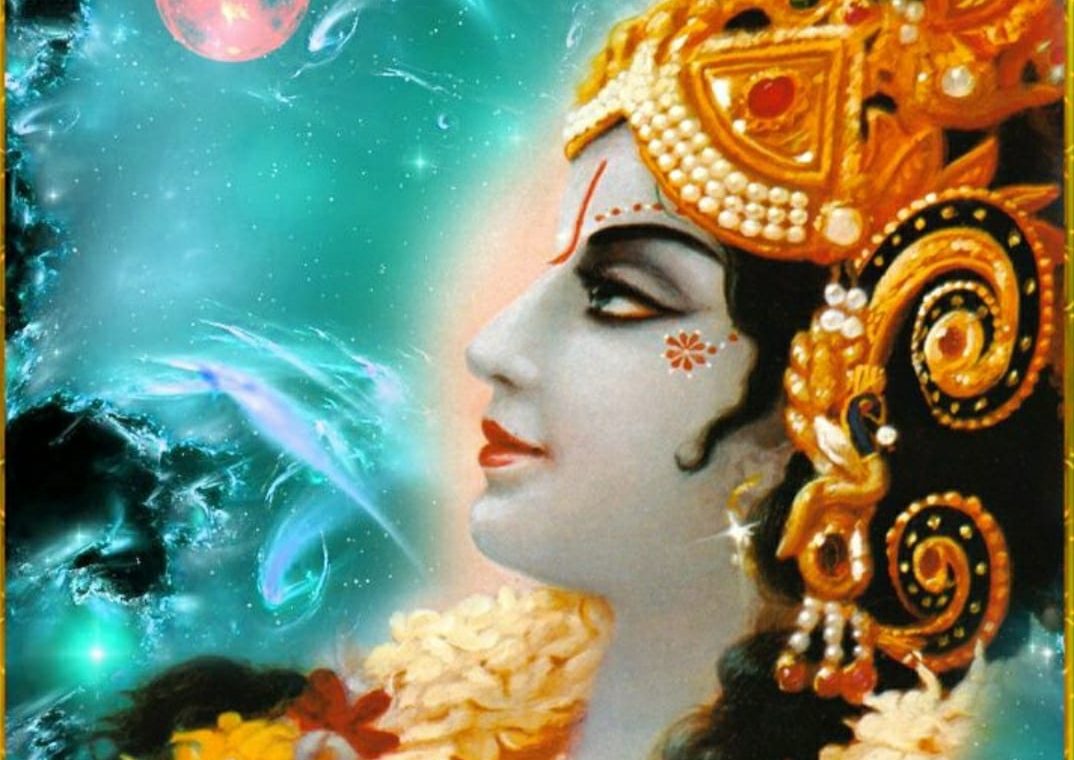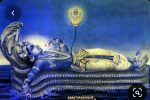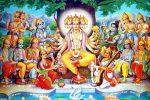NAME 49
AMARAPRABHUḤ अमरप्रभुः
The master of all the ‘immortals’ i.e. the Devas (who are immortal in a relative sense when compared to normal human lifespans). The Supreme being who directs and assigns duties to the other gods and devas.
This is a compound-word consisting of the terms amara (अमर) and prabhu (प्रभु) Amaraprabhuḥ
The Master (prabhuḥ) of ‘amara’s (amarāṇām) or the deathless ones, i.e. the devatās.
Amara refers to immortals and prabhu means the chief. Amara here refers to gods and goddesses. There are certain sages who remain immortals. Viṣṇu is the only Lord for these immortals. This means that immortals worship only the Brahman and they do not resort to worshipping anyone less than the Supreme Reality. This nāma says that Viṣṇu is the Brahman. Though the Brahman is beyond shapes and forms and cannot be known through names and forms, for the sake of understanding the Brahman, such names and forms are used for easy perceptiveness.
The deathlessness (amarattva) of the devas is a relative (āpekṣika) one.
Amarāṇāṃprabhuḥ – The master of Amarās or the deathless ones i.e., the Devās.
śrī-ṛṣir uvāca
manavo manu-putrāś ca
Śrīmad Bhāgavata – Canto 8, Chapter 14, Verse 2
munayaś ca mahī-pate
indrāḥ sura-gaṇāś caiva
sarve puruṣa-śāsanāḥ
All the Manus, the sons of every such Manu (who would be appointed as major Kings), all the Munīs (sages which includes the 7 great sages called SaptaR̥ṣis), all the Indrās (king of Gods) and other Devatās (Gods) and all such are under the rule of the ParamaPuruṣa or Supreme person.
४९. ॐ अमरप्रभवे नमः |
49. OM Amaraprabhave Namaḥ
Amaraprabhuh -The Lord (“prabhu”) of the Immortals (“a-mara”), the Devas. The Denizens of the Heavens, including all the office bearers therein (Dikpaalakas etc.) along with Indra, are called ‘Devas’, and they enjoy in their heavenly state a relative immortality.
The devas live and continue functioning till the great dissolution-the Sleep of the Creator. Compared with the short span of the existence of man on this globe, the aeons through which the Devas live can be considered as end- less or immortal. One who serves them with His might, giving protection and security to all creatures, is called, therefore, Amaraprabhuh.
INTERPRETATION GUIDED BY SANT VANI (WORDS OF SAINTS)
Amaraprabhuh
The Lord of the devas.
The master of all the ‘immortals’ i.e. the Devas (who are immortal in a relative sense when compared to normal human lifespans). The Supreme being who directs and assigns duties to the other gods and devas.
This is a compound-word consisting of the terms amara (अमर) and prabhu (प्रभु).
Classical commentaries of both Śaṅkara and Parāsara Battar do not include the seven ciranjīvis, चिरञ्जीवि who are expected to live till the end of the Kali Yuga but we could perhaps include them as well (and also perhaps add Sage Markendaya as well).
अश्वत्थामाबलिर्व्यासोहनूमांश्चविभीषण:।
कृप: परशुरामश्चसप्तएतैचिरजीविन:॥
सप्तैतान्संस्मरेन्नित्यंमार्कण्डेयमथाष्टमम्।
जीवेद्वर्षशतंसोपिसर्वव्याधिविवर्जित॥
AshwathaamaBalirvyaasoHanumanshchaVibheeshanaha
KrupahaParshuramaschaSaptaiteyChiranjivinaha
SaptaitaanSamsmareynnityamMarkandeymathaashtamam
JivedvarshshatamSopiSarvavyadhivivarjit
“Remembering the 8 great immortals, a human can live to be hundred, while at the same time being free of all illnesses”.
The devas, who are the citizens of svarga are called amaras, because they are maraṇa-rahita, do not age. Because of a lot of punya, they are exalted beings. Please note that the word used is svarga which is strictly not the ‘heaven’ of popular understanding. Other religions present heaven as eternal, from where there is no return.
Svarga as described in our shastra, is a temporary place of much enjoyment, a happy place where there are no core issues because one has a celestial body and also a place where there are no sufferings. Lord Death does not enter there. The devas live there for a very long time.
Once the punya runs out, very similar to the credit card bill exceeding the credit limit, the being will return to another loka, another field of experience. This amaratva, immortality for the devas is only an āpekṣi a-amaratva, a relative immortality.
The human body, while being one composite whole, has different organs with different
functions. The eye has a different function as compared to the pancreas. The ear has quite another function to perform as compared to the alimentary canal. Each function of each organ can be likened to a being, the one in charge, a deva. As He is the Lord of all, He is the Lord of the devas also.
The body with all its attributes, capabilities and talents is still mortal. Atma never dies, however, what makes a human immortal is his conduct?
“Without gentle words, noble intentions and truthful actions, we are worth no more than the sum total of our possessions. The journey from humanity to divinity is paved with good conduct. People may want us for what we do for them, they may respect us for what we have, ultimately though, they love us for how we make them feel. And, how we make others feel is almost entirely dependent on our conduct. It’s as simple as that.” – Om Swami
https://os.me/the-basis-of-honor/
“In our pursuit for eternity we forget to appreciate, have gratitude for and relish the beauty of the present moment.
Simplicity is spirituality” – Om Swami
To find joys of simple beautiful life while we are alive is in the true sense to live the immortality of a moment in eternity.
“If we are not frolicking with life while we are here, if we are not sportive while we have a chance, how could we possibly enjoy anything in any other world (or lifetime)? After all, we carry the same tendencies forward. It’s now or never. This is it, this life, however it is, it’s a boon. Why live it any other way?
Sparrows come when the sun is out, they hunt for food and fly back to their nest in the evening. Quite similarly, soul finds a womb when the time is right, lives a life and goes back to merge in the Supreme Consciousness. Or, it is reborn to fulfill its desires like the hungry bird that continues flying in search of food. This is the cycle of samsara. This is the mystical play of nature. Transient but eternal. Sophisticated yet simple.
At any rate, it is a blessing. Like our lives, like our planet. Beautiful.” – Om Swami
There is an interesting story connected to this particular name:
Shri Melpathur Narayana Bhattathiri, (1560–1666 CE), a great Sanskrit scholar and author of the poetic masterpiece Nārāyaṇīyam was a contemporary of another poet Shri Poonthanam Nambudiri (1547–1640 CE) – unlike the former, Poonthanam was not a Sanskrit scholar and wrote almost exclusively in Malayalam but was devoted to the form of Viṣṇhu namely Guruvayurappan.
Once at a ViṣṇuSahasranama recital Poonthanam wrongly chanted “Padmanābhaḥ-Amaraprabhuḥ” as ‘Padmanābhaḥ-Maraprabhuḥ Mara stands for ‘tree’, whereas Amara stands for “immortal”.
On hearing this it is said that Melpathur laughed aloud mocking and humiliating Poonthanam. Then, all those who had assembled there heard a divine voice declare “I am also Maraprabhuḥ” Guruvayurappan himself had come to the aid of his devotee and intervened to save him from humiliation.
To commemorate this divine event, sculptor P.V. Ramachandran designed and helped construct a 52-feet terracotta sculpture of “Guruvayur Maraprabhu.” This is considered the largest terracotta sculpture in the world. Standing in the form of a tree, this large terracotta Mūrti is considered to be the embodiment of all herbal and medicinal plants in the world. Devotees strongly believe that incurable ailments and diseases also could be cured if one visits this kṣétra. It is believed that several medicinal herbs were incorporated in creating this Mūrti.



